Best Customer Retention Software
Best customer retention software are Zendesk, Olark, Qualtrics, and BlueVein, Using customer retention analytics software you can plan different strategies and work on retaining more customers for the business.



No Cost Personal Advisor
List of 20 Best Customer Retention Software
Category Champions | 2024
Software by HubSpot
HubSpot Client Management Software helps to business to keep the complete eye on each and every leads and touch point with those leads to track the lead status. Hubspot lead scoring system helps sales team reduce the time and efforts in filtering out the bulk lead. Read Hubspot CRM Reviews
Explore various Hubspot CRM features, compare the pricing plans, and unlock the potential of seamless operations by selecting the right software for your business.
Features
View all Hubspot CRM Features- Meeting scheduling and coordination
- Inventory Management
- Email Marketing / SMS Marketing
- Sales Quotes
- Customization
- Account Management
- Marketing Analytics
- Customer Engagement
Pricing
Hubspot CRM Caters to
- StartUps
- SMBs
- Agencies
- Enterprises
Category Champions | 2024
Cloud-based Customer Support Software
Deliver exceptional customer service with Freshdesk Online Customer Support and Help Desk. Freshdesk is the customer support software that gives you everything you need to delight your customers. Read Freshdesk Reviews
Explore various Freshdesk features, compare the pricing plans, and unlock the potential of seamless operations by selecting the right software for your business.
Features
View all Freshdesk Features- Issue Tracking
- Online Activation
- Live chat system
- Help Desk Management
- Ticket Management
- Service Level Management
- Knowledge Base
- Automated Routing
Pricing
Freshdesk Caters to
- StartUps
- SMBs
- Agencies
- Enterprises
Category Champions | 2024
Software by Olark
Olark is the most beautiful and effective live chat software to talk to your customers for sales and support. And we make it super easy for you! Solve customer problems before they have a chance to click away. Read Olark Reviews
Explore various Olark features, compare the pricing plans, and unlock the potential of seamless operations by selecting the right software for your business.
Features
View all Olark Features- Persistent Chat
- Automatic Chat Translation
- Shortcut Messages
- Visitor Targeting
- Call Me Option
- Assignment Management
- File Sharing
- Real Time Monitoring
Pricing
Olark Caters to
- StartUps
- SMBs
- Agencies
- Enterprises
Category Champions | 2024
Customer retention made easy
Zendesk builds software for better customer relationships. People interact with businesses every day across multiple channels like email, phone, live chat, and social media. Zendesk brings all this together in one beautifully simple help desk software platform, enabling you to create more meaningful and productive relationships with your customers. Read Zendesk Reviews
Explore various Zendesk features, compare the pricing plans, and unlock the potential of seamless operations by selecting the right software for your business.
Features
View all Zendesk Features- Assignment Management
- Queue Management
- IVR / Voice Recognition
- Knowledge Base
- Progressive Dialer
- Real Time Monitoring
- Customer Experience Management
- API Integration
Pricing
Support Team
$ 19
Agent/Month
Support Professional
$ 55
Agent/Month
Support Enterprise
$ 115
Agent/Month
Zendesk Caters to
- StartUps
- SMBs
- Agencies
- Enterprises
Category Champions | 2024
All-in-one customer experience solution
Tidio offers all in one customer experience platform that includes live chat, chatbots, the Lyro AI chatbot, ticketing, email marketing, and multichannel communication capabilities.. Read Tidio Reviews
Explore various Tidio features, compare the pricing plans, and unlock the potential of seamless operations by selecting the right software for your business.
Features
View all Tidio Features- Customer Support Tracking
- Customer Profiles
- Personal Greetings
- Automated Routing
- Chatbot Automation
- Instagram Integration
- Customer Data
- Visitor Targeting
Pricing
Customer Service
$ 29
Per Month
Lyro AI Agent
$ 39
Per Month
Automation
$ 29
Per Month
Tidio Caters to
- StartUps
- SMBs
- Agencies
- Enterprises
Contenders | 2024
The world’s most flexible loyalty software for cre
Open Loyalty is the #1 Headless Loyalty Platform with the most flexible set of loyalty blocks for building personalized loyalty programs, with the API-first approach and 50+ pre-built loyalty mechanics like points, tiers, or rewards. Read Open Loyalty Reviews
Explore various Open Loyalty features, compare the pricing plans, and unlock the potential of seamless operations by selecting the right software for your business.
Features
View all Open Loyalty Features- Feedback Collection
- Contact Management
- Customer Segmentation
- Loyalty Program
- Gamification
- Device management
- Discount Management
- Churn Management
Open Loyalty Caters to
- StartUps
- SMBs
- Agencies
- Enterprises
Contenders | 2024
Customer & User Feedback Software
Qualaroo is a fully featured Survey Software designed to serve SMEs, Enterprises. Qualaroo provides end-to-end solutions designed for Web App. This online Survey system offers Mobile Survey, Site Intercept Survey, Email Marketing, Question Branching, Offline Response Collection at one place. Read Qualaroo Reviews
Explore various Qualaroo features, compare the pricing plans, and unlock the potential of seamless operations by selecting the right software for your business.
Features
View all Qualaroo Features- Web Surveys
- User Journeys
- Customizable Questions
- Skip Logic
- Surveys & Feedback
- 360 Degree Feedback
- Mobile Survey
- Feedback Management
Pricing
Essentials
$ 80
Single User
Premium
$ 160
3 Users
Qualaroo Caters to
- StartUps
- SMBs
- Agencies
- Enterprises
Contenders | 2024
Software by Hotjar
Hotjar is a lead capture software, packed with robust features required to leverage your user analysis and feedback initiatives. It helps you understand your user better by providing complete visibility and instant feedback on the user's experience on your website. Read Hotjar Reviews
Explore various Hotjar features, compare the pricing plans, and unlock the potential of seamless operations by selecting the right software for your business.
Features
View all Hotjar Features- Feedback Collection
- User Journeys
- Question Library
- Question Branching
- For Websites
- Usability Testing
- Website Analytics
- Heatmaps
Hotjar Caters to
- StartUps
- SMBs
- Agencies
- Enterprises
Contenders | 2024
Software by Baremetrics, Inc
We know Baremetrics works wonders. It has for us! That's why we offer a risk-free, 60-day guarantee. If Baremetrics doesn't work for you in the first 60 days, no problem. We'll give you a full refund. Read Baremetrics Reviews
Explore various Baremetrics features, compare the pricing plans, and unlock the potential of seamless operations by selecting the right software for your business.
Features
View all Baremetrics Features- CRM integration
- Sales Reporting
- Purchase Orders
- Applications Management
- Application Integration
- Email Integration
- Opportunity Management
- Sales Analytics
Pricing
Startup
$ 50
Per Month
Professional
$ 100
Per Month
Business
$ 250
Per Month
Baremetrics Caters to
- StartUps
- SMBs
- Agencies
- Enterprises
Contenders | 2024
Software by Yotpo
One of the most powerful of Yotpo Loyalty Software is generated customer content management like drive traffic, reviews, marketing and increase sales managing in the loyalty solutions. It has increase reviews leading to higher on-site marketing without effective and SEO ranking. Read Yotpo Reviews
Explore various Yotpo features, compare the pricing plans, and unlock the potential of seamless operations by selecting the right software for your business.
Features
View all Yotpo Features- Rewards Management
- Loyalty Management
- Loyalty Card System
- Member Portal
- Automation Rules
- CRM
- Membership Management
- Event Calendar
Yotpo Caters to
- StartUps
- SMBs
- Agencies
- Enterprises
Contenders | 2024
Software by Zapier Inc
Zapier is the main intelligent management software that connects automation to regular uses for users. It has a nice user layout. Innovative design attracts the users and generates traffic on that. Read Zapier Reviews
Explore various Zapier features, compare the pricing plans, and unlock the potential of seamless operations by selecting the right software for your business.
Pricing
Free
$ 0
Per Month
For Work
$ 20
Per Month
For Teams
$ 250
Per Month
Zapier Caters to
- StartUps
- SMBs
- Agencies
- Enterprises
Emergents | 2024
Product Experience Software for Onboarding & Adopt
Userpilot helps teams increase user adoption by allowing them to trigger the right in-app experience to the right persona at the right stage of their user journey. Code-Free. Your Product’s Native UI Easily integrate Userpilot with your product’s UI and pass user data. Learn more about Userpilot
Explore various Userpilot features, compare the pricing plans, and unlock the potential of seamless operations by selecting the right software for your business.
Pricing
Basic
$ 149
Per Month
Pro
$ 239
Per Month
Userpilot Caters to
- StartUps
- SMBs
- Agencies
- Enterprises
Contenders | 2024
Powerful product analytics to find, engage, and re
Mixpanel gives everyone the ability to answer complex product questions with ease. Our robust, self-serve product analytics solution helps teams query real-time data and build visualizations quickly to understand product usage trends. Read Mixpanel Reviews
Explore various Mixpanel features, compare the pricing plans, and unlock the potential of seamless operations by selecting the right software for your business.
Features
View all Mixpanel Features- Push Notifications
- In-App Events Tracking
- Data Quality Control
- Data Analysis
- Website Analytics
- Dashboard
- Data Integration
- Retention Tracking
Pricing
FREE
$ 0
Per Month
GROWTH
$ 17
Per Month
ENTERPRISE
$ 0
Custom plans and pricing to suit your needs
Mixpanel Caters to
- StartUps
- SMBs
- Agencies
- Enterprises
Emergents | 2024
The Science-First Relationship Marketing Hub
Optimove is a fully featured Online Campaign Management Software designed to serve Agencies, SMEs. Optimove provides end-to-end solutions designed for Windows. This online Online Campaign Management system offers Channel Management, Gamification, Contact Database, Event Triggered Actions, Communication Management at one place. Learn more about Optimove
Explore various Optimove features, compare the pricing plans, and unlock the potential of seamless operations by selecting the right software for your business.
Features
View all Optimove Features- GDPR Compliance
- Event Triggered Actions
- Visual Editor
- CRM integration
- Goal Tracking
- Audience Targeting
- Analytics
- Conversion Tracking
Optimove Caters to
- StartUps
- SMBs
- Agencies
- Enterprises
Contenders | 2024
Software by Whatfix Inc
Whatfix is a powerful and user-friendly customer support system. It can be easily used to seamlessly all user touch points such as e-mail, chat and social media. It is designed to accommodate customer evolving needs, so that right supported deliver at right time, throughout entire lifecycle. Read Whatfix Reviews
Explore various Whatfix features, compare the pricing plans, and unlock the potential of seamless operations by selecting the right software for your business.
Whatfix Caters to
- StartUps
- SMBs
- Agencies
- Enterprises
Category Champions | 2024
#1 CRM & support solution for growing businesses
Salesforce makes it easy for small businesses and startups build stronger client relationships with an all-in-one sales and support solution that is easy to use, setup, and maintain - Best client management software with standard cost. Read Salesforce Reviews
Explore various Salesforce features, compare the pricing plans, and unlock the potential of seamless operations by selecting the right software for your business.
Features
View all Salesforce Features- Billing Inquiry Manager
- Time Planning
- Analytics
- Sales pipeline management
- Sales Pipeline Tracking
- Ticket/Issue Tracking
- Call Logging
- Contact Import/Export
Pricing
Starter Suite
$ 25
User/Month
Professional
$ 80
User/Month
Enterprise
$ 165
User/Month
Salesforce Caters to
- StartUps
- SMBs
- Agencies
- Enterprises
Contenders | 2024
Software by Keap
Keap CRM is a fully featured Sales Automation software designed to serve SMEs, Startup, Agencies, Enterprises. Keap CRM provides end-to-end solutions designed for Web App. This Sales Automation software offers Acquiring new leads, Email marketing, Client management (CRM) at one place. Read Keap CRM Reviews
Explore various Keap CRM features, compare the pricing plans, and unlock the potential of seamless operations by selecting the right software for your business.
Keap CRM Caters to
- StartUps
- SMBs
- Agencies
- Enterprises
Emergents | 2024
Trusted by the industry’s leader
With the help of Qualtrics, you can easily optimize your customer metrics, identify at-risk and vulnerable customers and take remedial actions instantly. The constructive net promoter score software monitors the product improvement and measures the customer feedback. Learn more about Qualtrics
Explore various Qualtrics features, compare the pricing plans, and unlock the potential of seamless operations by selecting the right software for your business.
Features
View all Qualtrics Features- Custom Survey URLs
- Feedback Collection
- Real Time NPS Tracking
- Community Management
- Data Analysis Tools
Qualtrics Caters to
- StartUps
- SMBs
- Agencies
- Enterprises
Contenders | 2024
Accelerate your Business growth with our data-driv
Churn360 is a data-driven AI customer success platform that helps SaaS businesses reduce churn and increase the lifetime value of customers. Churn360 provides a central portal for daily tasks for your CSMs to integrate with all the supported third party software. Read Churn360 Reviews
Explore various Churn360 features, compare the pricing plans, and unlock the potential of seamless operations by selecting the right software for your business.
Features
View all Churn360 Features- Funnel Analysis
- Surveys & Feedback
- Reporting and Dashboards
- Audience Segmentation
- Campaign Segmentation
- Usage Tracking / Analytics
- Churn Management
- Onboarding
Pricing
Professional
$ 799
Per Month for 5-9 users
Startup
$ 399
Per Month for 1-4 users
Churn360 Caters to
- StartUps
- SMBs
- Agencies
- Enterprises
Emergents | 2024
Software by Forethought
Forethought is a fully featured Customer Support Software designed to serve SMEs, Startup, Agencies, Enterprises. Forethought provides end-to-end solutions designed for Web App. This Customer Support Software offers Onboard Agents Seamlessly, Solve Tickets Faster, Simpler Customer Service at one place. Learn more about Forethought
Explore various Forethought features, compare the pricing plans, and unlock the potential of seamless operations by selecting the right software for your business.
Features
View all Forethought Features- Work order management
- Action Management
- Dashboard
- Customer DataBase
- Knowledge Management
- Live Chat
- Surveys & Feedback
- Document Storage
Forethought Caters to
- StartUps
- SMBs
- Agencies
- Enterprises
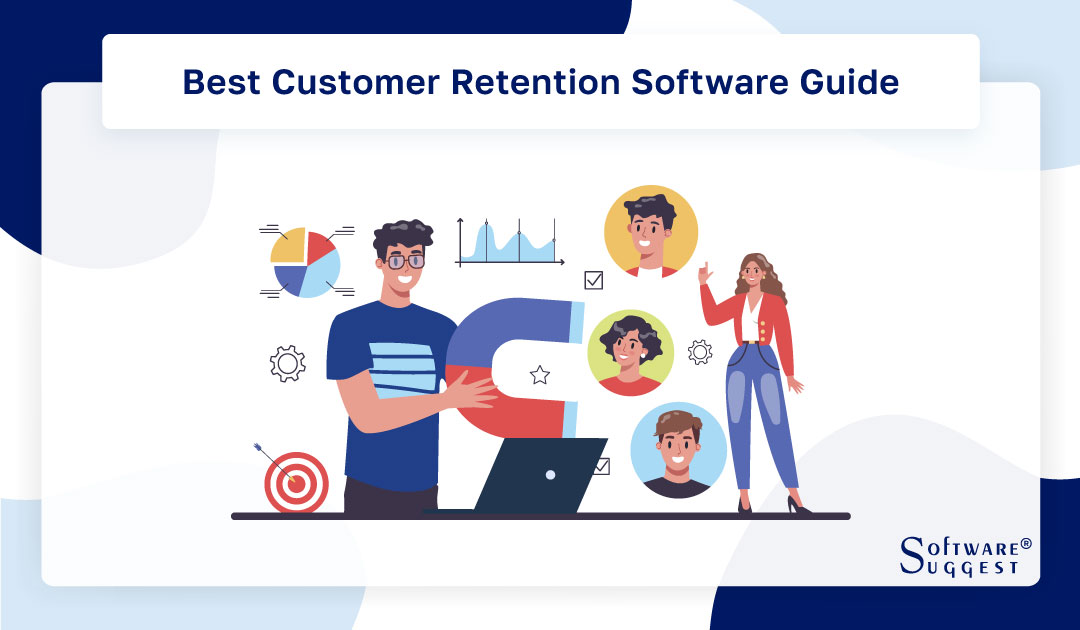
Gone are the days of relying on manual processes and guesswork to retain customers. Customer retention software harnesses the power of advanced analytics, automation, and artificial intelligence to unveil invaluable insights and proactively address customer queries and concerns.
Irrespective of whether you operate in the e-commerce sector, SaaS industry, or any other customer-centric domain, the best customer retention software stands as your ultimate companion in cultivating a steadfast customer base.
It empowers businesses to outpace the competition by consistently delivering exceptional experiences that entice satisfied customers coming back to return time and again.
What Is Customer Retention Software?
Customer retention software is a specialized tool that helps businesses in their quest to retain current customers and foster enduring relationships with them. In today's fiercely competitive business landscape, effective customer retention tools stand as a make-or-break factor for sustainable growth and profitability. This elevates the significance of this software to a highly valuable asset.
This software includes a diverse range of features and functionalities. These equip businesses with the ability to gain deep insights into customer behavior and uncover patterns that heighten customer satisfaction and thereby increase customer retention and loyalty thereafter. Leveraging cutting-edge technologies such as analytics, automation, and artificial intelligence, this software facilitates the collection and analysis of customer data, predicts their evolving needs, and delivers personalized experiences tailored to their preferences.
By embracing a customer retention system, businesses are empowered to proactively address customer issues and concerns, monitor interactions and preferences, automate communication processes, and orchestrate targeted marketing campaigns that nurture customer relationships. This transformative software allows businesses to optimize their customer retention endeavors, curtail customer churn, and amplify the customer lifetime value of each customer.
What Role Does Customer Retention Software Play?
Customer retention software is a crucial tool that empowers businesses to establish and maintain strong customer relationships. It offers a diverse range of functionalities that minimize churn and foster long-term business growth.
Some of the most common ways how a customer retention software helps are written below. Let’s take a look at them right away!
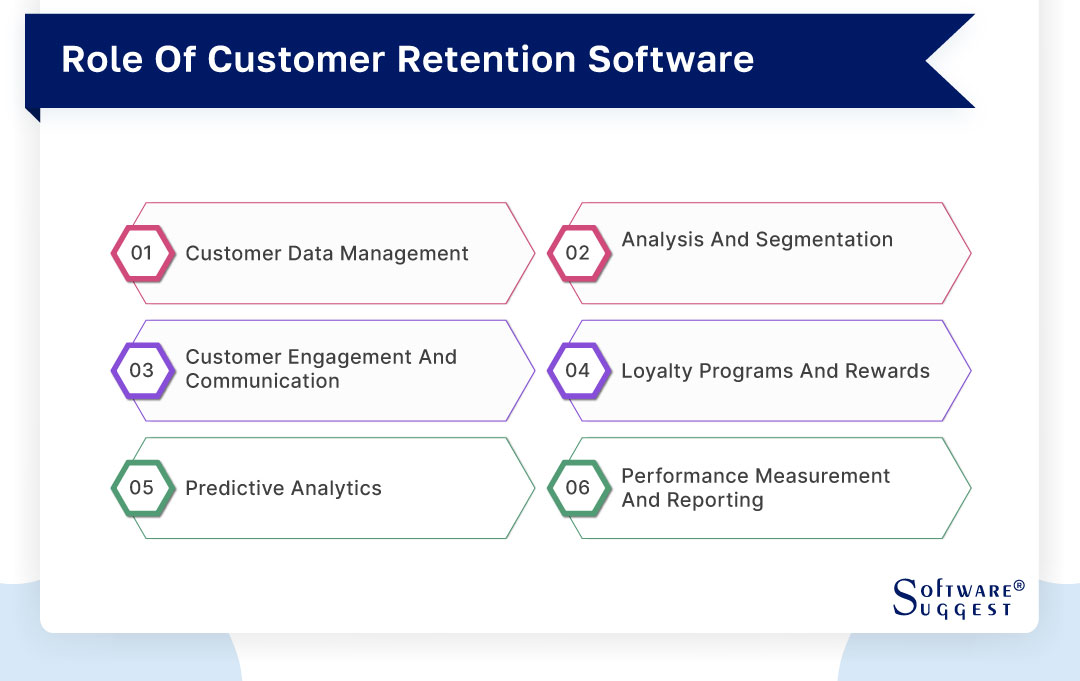
-
Customer data management
By harnessing customer retention software, businesses can easily gather and analyze comprehensive data on customer interactions, purchases, and engagement across diverse channels. This facilitates a deeper understanding of customer preferences, interests, and needs through data-driven insights.
Armed with this knowledge, businesses can segment their customer base and devise personalized marketing campaigns to enhance engagement.
-
Analysis and segmentation
Customer retention software helps with analysis and segmentation by utilizing cutting-edge algorithms and data analytics approaches to derive useful insights from customer data. It examines a range of variables, such as consumer behavior, preferences, purchase patterns, and interactions, in order to identify significant trends and patterns.
These insights are then used to divide clients into several categories based on similarities and differences. Through segmentation, businesses can better understand their clients, which also enables them to create tailored marketing plans and retention tactics.
-
Customer engagement and communication
Customer retention tools enable organizations to better interact and communicate with their customers. It offers a variety of tools and capabilities that enable individualized and targeted communication across channels like email, SMS, push notifications, and in-app chat.
Furthermore, companies can track consumer engagement indicators like email open rates and click-through rates to determine the efficiency of their communication initiatives.
-
Loyalty programs and rewards
Customer retention software often includes robust features for managing customer loyalty programs more effectively. These programs incentivize repeat purchases and reward loyal customers, fostering a sense of appreciation and exclusivity.
By meticulously gathering and analyzing customer data, such software empowers businesses to grasp the preferences, behaviors, and needs of their customers.
These further help them to drive greater participation and enhance customer retention. As customers feel cherished and truly comprehended, they are far more inclined to remain steadfast supporters of the brand.
-
Predictive analytics
Customer retention software uses predictive analytics to analyze historical data and uncover significant patterns, trends, and correlations that can accurately predict customer behavior, such as churn, loyalty, and engagement. With the help of advanced algorithms, the software creates predictive models that estimate the likelihood of specific customer actions or events.
By embracing predictive analytics, customer retention software enables businesses to make informed decisions based on data, optimize resource allocation, and achieve better outcomes in their customer retention efforts.
-
Performance measurement and reporting
A useful tool for tracking and reporting customer retention performance is customer retention software. Businesses may track KPIs like customer churn rate, customer lifetime value, repeat purchase rate, and customer satisfaction ratings thanks to its comprehensive insights and analytics.
Businesses can assess the success of their retention efforts and identify areas for improvement by looking at these measures. The program creates thorough reports and graphics that clearly and easily explain critical performance indicators. This makes it possible for organizations to make data-driven decisions seamlessly.
With customer retention software by their side, companies can elevate customer satisfaction and take their business to the next level with ease.
Main Benefits of Customer Retention Software
The fast-paced globe has thrust customer retention into the limelight for organizations spanning diverse industries.
Retaining existing customers not only proves more cost-effective than acquiring new ones but also serves a wide range of benefits. Some of these include -

-
Reduced churn rate
The rate of customer churn can have a negative impact on a company's overall profitability and growth trajectory. This is where customer retention software comes into play. It offers priceless insights into consumer behavior that enable businesses to pinpoint those clients at risk of severing ties.
With this knowledge, businesses can then take proactive steps to prevent or reduce churn, such as running targeted marketing campaigns, creating personalized offers, or quickly addressing customer complaints. Businesses can preserve a steady customer base and avoid the high costs involved with acquiring new customers by successfully reducing customer churn.
-
Improved customer engagement
Customer experience is a powerful force that shapes a company's success. Customer retention software takes on the responsibility of improving this experience by providing businesses with the ability to deliver interactions that are personalized, timely, and extremely relevant.
Businesses can serve product or service recommendations tailored to individual needs, and quickly resolve any grievances that may arise by capitalizing on a wealth of customer data. Businesses can sow the seeds of stronger relationships by maintaining an unwavering focus on improving the customer experience.
-
Enhanced personalization
A key benefit for businesses is the greater personalization that customer retention management software offers. Utilizing consumer data and insights, businesses may tailor their communications and goods to certain customers.
This level of customization fosters a stronger sense of connection and commitment because clients feel valued and understood. With personalized communication, targeted promotions, and individualized recommendations, businesses may offer a more interesting and pertinent customer experience.
-
Optimized marketing and sales strategies
Customer retention software offers a number of advantages, including optimized marketing and sales strategies. This software enables companies to understand client behavior, preferences, and purchase trends by utilizing data and analytics.
Using this data, businesses may develop individualized offers, focused marketing campaigns, and personalized messaging that will increase consumer happiness and retention.
Through this tier-based loyalty program, organizations may improve their marketing and sales strategies, increase client engagement, and boost long-term profitability by using a retention automation platform.
-
Increased customer lifetime value
Customer retention software aims to support organizations in nurturing and enhancing their relationships with current customers. A key benefit of this software is its capability to elevate customer lifetime value (CLV).
Customer lifetime value represents the total revenue that a customer generates for a company throughout their association. It factors in the duration of the customer's relationship, the frequency of purchases, and the average transaction value.
-
Data-driven decision making
Data-driven decision-making is a prominent benefit of customer retention software. Businesses get useful insights that influence their strategy through the gathering and analysis of customer data. With the use of this software, firms may discover different consumer segments and tailor their efforts to keep those customers.
The program enables organizations to make data-supported decisions on tailored communication, targeted marketing campaigns, and improvements to the customer experience by tracking customer behavior, preferences, and engagement indicators.
By effectively using customer data and insights, businesses can tailor their customer retention strategy, communications, and offerings to meet individual customer needs. Investing in client retention software brings long-term benefits, fostering stronger relationships, driving growth, and enhancing competitiveness in the market.
Why Do You Need Customer Retention Software?
Acquiring new customers can be both expensive and time-consuming, making it more cost-effective to focus on retaining existing customers. This is where customer retention software comes in.
Being a highly valuable tool, it helps businesses understand their customers better. Some of the top-notch reasons why you need customer retention software are written below. Let’s dig deep!
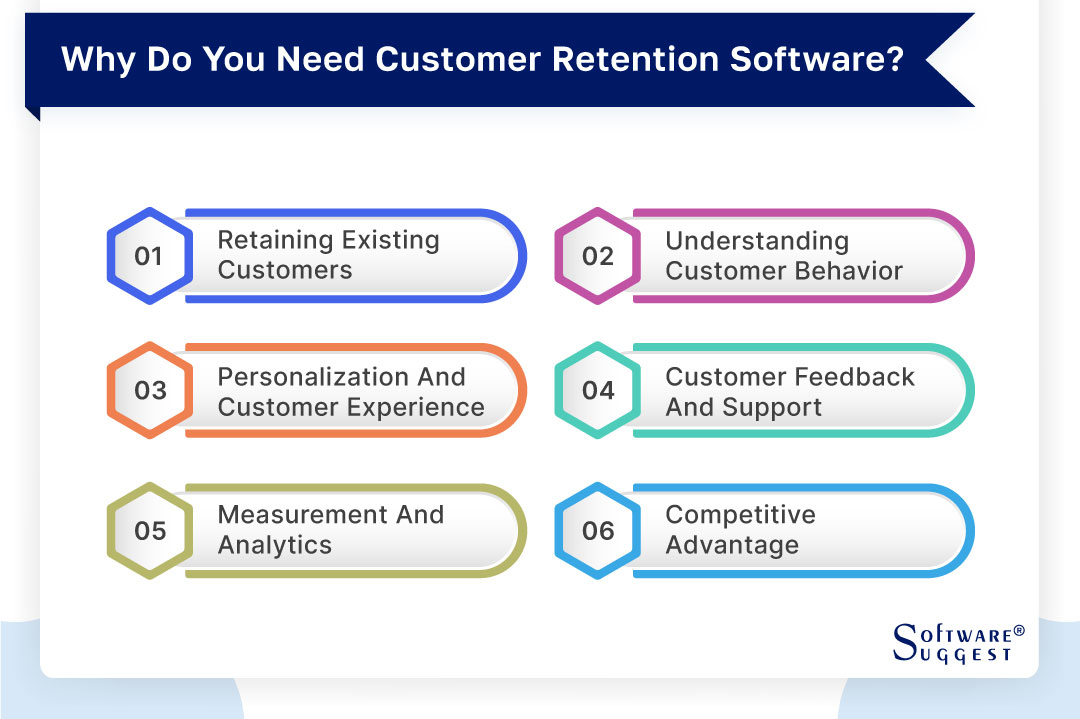
-
Retaining existing customers
Customer retention software is critical for organizations that want to keep their current consumers. It offers a wide range of tools and tactics to help achieve this goal. The software provides consistent encounters that resonate with clients by providing customized communication and engagement.
Businesses can target their retention efforts to specific groups by using customer segmentation, maximizing their efficacy. The software uses predictive analytics to detect at-risk customers and chances for cross-selling or upselling. It also simplifies the collection and processing of client feedback, allowing for product and service enhancements.
-
Understanding customer behavior
Retention automation software provides businesses with valuable insights into their customers' behaviors, preferences, and needs. By analyzing customer data such as purchase history, and interaction patterns, businesses can gain an in-depth understanding of their customers.
This insight enables businesses to personalize their approach, create relevant offers, and improve the overall customer experience. With this, businesses can build stronger relationships with their customers, leading to increased loyalty and higher retention rates.
-
Personalization and customer experience
Customer retention software enables organizations to build personalized experiences for each customer by leveraging customer data and insights. It enables customized communication by recommending appropriate products or services based on client preferences and habits.
Businesses may strengthen connections by delivering timely and targeted communications, offers, and content via automation and segmentation options.
Furthermore, customer retention software tracks customer interactions, allowing businesses to develop a better understanding of their customers' requirements. This leads to better customer experiences and higher levels of satisfaction.
-
Customer feedback and support
Customer feedback and support are improved by using efficient tools for collecting, analyzing, and responding to customer feedback. Businesses can easily monitor and respond to customer concerns more quickly by centralizing feedback channels such as surveys, reviews, and social media.
The software categorizes feedback based on sentiment and topic, providing useful insights into areas that require improvement. It also automates the management of support tickets, ensuring timely responses and resolutions.
-
Measurement and analytics
Customer retention software is a crucial measuring and analytics tool that enables companies to compile and examine extensive customer data. By doing this, it provides insightful data that gauges the effectiveness of retention initiatives. Critical indicators like customer churn rate, customer lifetime value, and repeat purchase rate are tracked by the program, allowing retention efforts to be evaluated.
Additionally, it reveals patterns and trends in consumer behavior, enabling firms to make informed judgments. Businesses can increase the effectiveness of their customer retention activities by leveraging these tools to improve retention tactics and optimize customer retention programs.
-
Competitive advantage
Customer retention software provides businesses with a competitive advantage by assisting them in developing strong customer relationships. It recognizes customer preferences and feedback, allowing for more personalized offerings and better experiences.
Efficient support ticket management ensures timely resolutions, which increases customer satisfaction. Proactive engagement addresses issues as they arise, fostering trust and loyalty.
Investing in customer retention software is a strategic move that enables businesses of all sizes to improve customer loyalty, reduce churn, and ultimately drive long-term growth and profitability.
How to Choose Customer Retention Software?
With a plethora of options available in the market, selecting the right software can be a challenging task.
To help you make an informed decision, it's important to consider several key factors. Some of the most prominent ones are written below. Let’s take a look at them!
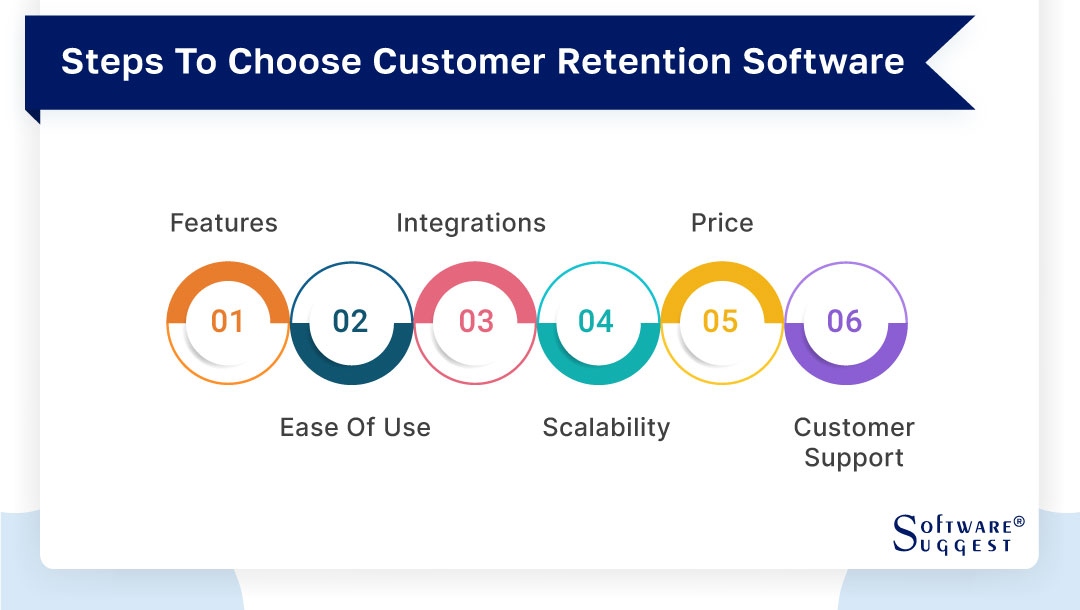
-
Features
Always look for features that complement the objectives and needs of your particular business. Customer segmentation, automated communication, feedback management, and analytics are typical features to take into account.
Examine whether the software offers the features you'll need to monitor and analyze customer behavior, communicate with customers, engage with them in a useful way, and assess how successful your customer retention efforts are.
-
Ease of use
Software that is easy to use is essential for facilitating adoption and maximizing productivity. Check the software's functionality and user interface to see if it complements the skills of your team.
Think about whether the software provides simple reporting, customizable dashboards, and intuitive navigation. Additionally, look for features that make creating and managing customer retention initiatives simpler, such as drag-and-drop campaign builders and pre-built templates.
-
Integrations
Retention management software should work in tandem with your current technology stack. Check the compatibility of the software with your customer relationship management (CRM) system, marketing automation tools, and other relevant platforms.
Integration capabilities allow data to flow between systems, allowing for a more comprehensive view of customer interactions and facilitating personalized retention strategies. Select software with robust APIs or pre-built integrations with commonly used software solutions.
-
Scalability
When choosing customer retention tools and platforms, take into account your company's future expansion plans. As your business grows, determine if the software can handle growing volumes of user data, campaigns, and how many customers calls. Scalable software ensures that as your business develops, you can manage and interact with your customers effectively.
-
Price
Examine the software's pricing structure, which may include both annual and monthly subscriptions. Take into account whether the program provides several pricing tiers or customized plans to meet your unique needs and spending limit.
It's crucial to strike a balance between the cost and the value and return on investment (ROI) that the program offers. Think about the possible long-term gains and revenue expansion that efficient client retention software can offer your company.
-
Customer support
When developing and utilizing client retention software, dependable customer assistance is critical. Examine the level of assistance provided by the program provider. These include channels of communication (e.g., email, phone, and chat), response times, and support documentation. Look for companies that give training materials, knowledge bases, and a committed support crew.
By considering all the above-mentioned factors, choosing the right software becomes a mere cakewalk. This is an important decision to make since it significantly impacts your business.
Top 5 Customer Retention Software With Pros, Cons, Features, and Pricing
|
Name
|
Free Trial
|
Demo
|
Starting Price
|
|---|---|---|---|
| 14-days |
Yes |
Starts with $800/month | |
|
14-days |
Yes | Starting price at $25 per user per month | |
|
14-days |
Yes |
Starting price at $49 per user per month | |
| 14-days |
No |
Starting price at $99 per user per month | |
|
14-days |
Yes |
|
Since now you are well aware of the importance of customer retention management software, it’s time to choose the best one for your business requirements. However, with so many options available, this task is not a simple one. This is where our list of top five customer retention software will help you out.
1. HubSpot
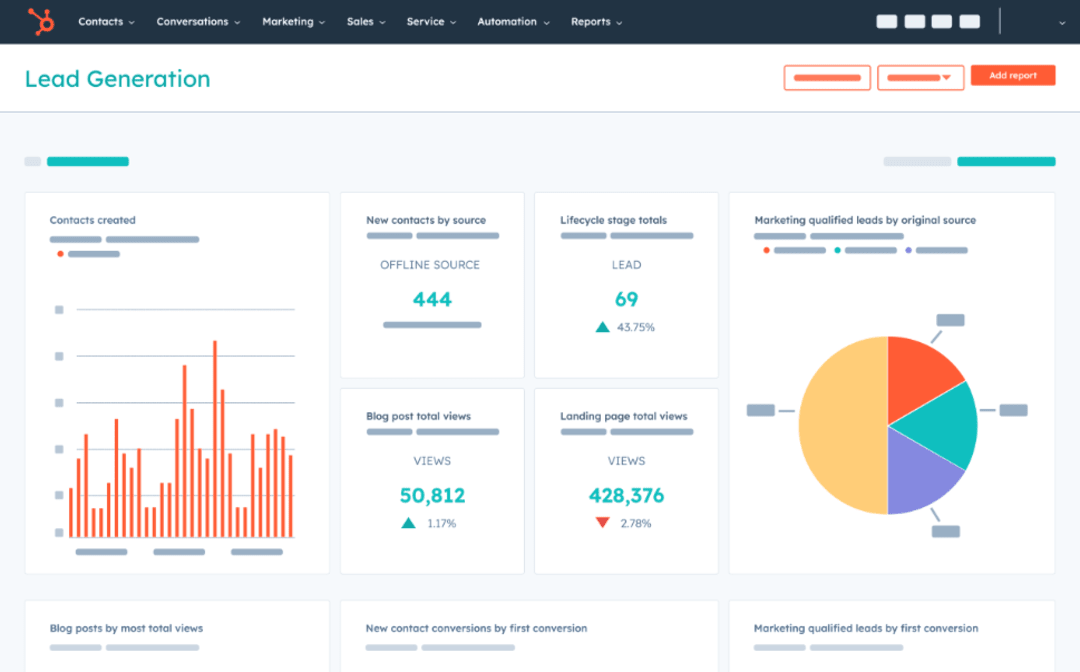
HubSpot is a powerful customer relationship management (CRM) platform that brings together different aspects of your business, including customer support, sales, and marketing. It offers a wide range of tools, integrations, and resources that support your business growth and increase revenue.
By facilitating seamless collaboration among teams, HubSpot enables you to have customers engage in a timely manner, ensuring efficient communication and superior customer satisfaction.
Key Features
- Contact management
- Reporting, dashboarding & visualizations
- Automatic data capture management
- Meeting scheduling
Pros
- It offers a highly intuitive UI that helps attract potential customers with ease
- It offers App Marketplace, which serves multiple integrations to easily connect with other tools
- Since the core CRM software is free forever, companies get their hands on this software easily
Cons
- This software is not budget-friendly
- The contracts offered by this software are not at all flexible
Pricing
-
Starts at $800/month
2. Salesforce

Salesforce CRM is a versatile platform that caters to diverse sales automation needs across all industries. It is primarily designed for large-scale enterprises with expanding sales teams, and it is a highly adaptable solution.
Salesforce, which has been in business for over two decades, proudly displays a diverse set of integrations, solidifying its position as an industry leader.
Key Features
- Forecast management
- Sales Pipeline management
- Marketing campaign management
- Mass emailing
Pros
- Its CRM is reachable 24/7 from any location in the world
- This software offers simple configuration and administration by cloud deployment
- It is more affordable than on-premises CRMs because it requires fewer IT resources to launch CRM
Cons
- This software cannot conduct business transactions without a stable internet connection
- It offers a lack of control over system upgrades and downtimes which causes difficulties
Pricing
-
Starts at $25 per user per month
3. Zendesk

Zendesk Talk is a comprehensive cloud-based platform for effectively managing customer communications. With Zendesk Talk, you can simply handle client conversations via web and phone channels while guaranteeing seamless interaction with your online customer experience.
Furthermore, the platform has extensive analytics capabilities that enable you to reliably analyze and evaluate the success of your phone assistance.
Key Features
- Interactive voice response (IVR)
- Ticketing system
- Multichannel messaging
- Unified agent workspace
Pros
- This software offers a very simple and easy-to-use interface
- It provides around six months of free service specifically for startups
- This software can easily be integrated with over 1,000 applications
Cons
- This software offers poor customer support
- It doesn’t offer international numbers
Pricing
-
Starts at $49 per user per month
4. Retently

Retently is a cutting-edge web-based customer experience management tool that measures customer happiness throughout the buyer journey and provides organizations with actionable information.
The program collects comments on retaining customers and conducts net promoter score (NPS) surveys to aid B2B firms with sentiment analysis. Businesses may successfully further identify customers as detractors and convert them into advocates by using these qualities, thereby increasing further customer count of loyal customers.
Key Features
- Targeted surveys
- Simple segmentation
- Transactional NPS campaigns
- Custom templates
Pros
- With this software, you can easily automate your campaigns through optimized NPS automation
- It offers multi-channel support, which helps to reach a larger number of customers
- This software can easily integrate with an extensive selection of native applications and third-party systems
Cons
- This software doesn’t offer a free trial
- At times, the software can slow down, which hampers work
Pricing
-
Starts at $99 per user per month
5. Totango
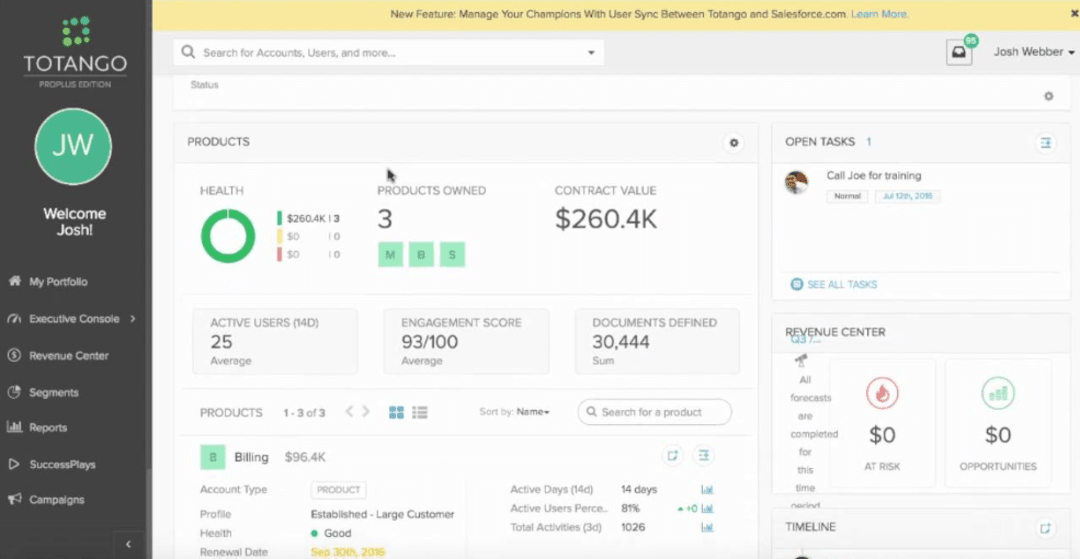
Totango is customer experience software that allows you to track health indicators throughout the customer journey. It is intended to provide a visual overview across customer engagement hierarchies to supplement reactive CRM solutions and sales pipelines.
The software is intended for large enterprises with multiple brands or market segments that are complex. It specifically targets SaaS and subscription businesses.
Key Features
- Customer segmentation
- Early warning systems
- Conversion streams
- Account management
Pros
- It helps to visualize multiple customer relationship hierarchies across various accounts, product lines, and channel partners.
- This software offers workflows that boost various business processes.
- It can easily be custom-integrated with various other enterprise systems.
Cons
- This software doesn’t provide a free trial.
- It is primarily suited for large organizations, which limits startups from adopting this software.
Pricing
-
On-request
How To Implement Customer Retention Software?
Customer retention software plays a crucial role in enhancing customer loyalty and reducing churn for businesses.
To ensure successful integration into your operations, implementing such software requires a systematic approach. Below are the top tips on how you can choose the best customer retention software. Let’s dig deep!
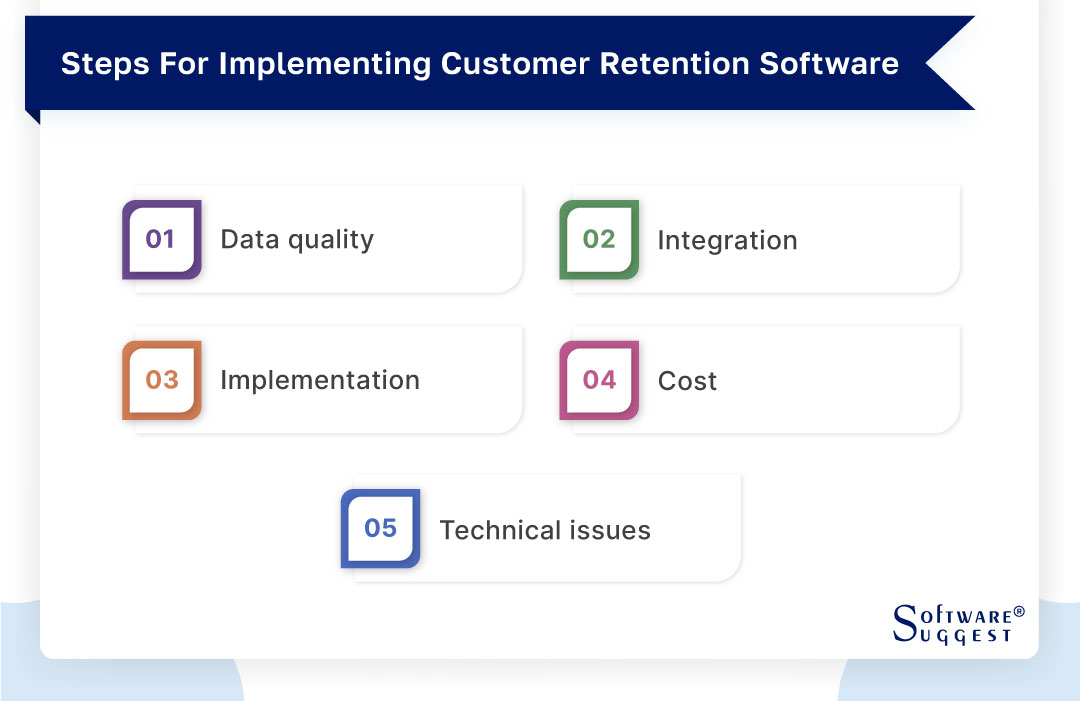
-
Define your objectives
Setting up clear goals is crucial before implementing any software solution. Establish your goals as to what you want to achieve with your customer retention tools. By clearly stating your goals, you can better coordinate your implementation strategy and establish a benchmark for the customer retention tool’s performance.
-
Research and select a software solution
Thorough research is required to identify the best customer retention software that is compatible with your company's needs and goals. Customer segmentation, automated communication tools, predictive analytics, and reporting capabilities are all desirable.
Consider evaluating various vendors, reading reviews, and seeking recommendations from industry peers. Scalability and compatibility with existing systems must also be considered.
-
Train your team
When you implement customer retention software, you must teach your staff how to use its features to their fullest potential. Your staff members, including the teams in customer service, marketing, and sales, should receive thorough training.
Make sure they are familiar with how to use the software, interpret customer data, and take advantage of its features to increase the customer retention rate. Training should concentrate on important topics like customizing customer experiences and studying consumer behavior.
-
Integrate with other systems
Customer retention management software should integrate seamlessly with your existing systems for maximum effectiveness. Determine which systems, such as CRM software, marketing automation tools, or customer service platforms, must be integrated. The integration provides a comprehensive view of customer data and enables better decision-making.
-
Develop a retention strategy
Creating a solid retention plan is crucial for using client retention software efficiently. Analyze your consumer data and divide your clientele into groups according to criteria like purchasing patterns, demographics, or degrees of engagement.
Use the software's skills to spot high-risk clients and launch focused retention strategies. To foster customer connections, create individualized communication plans, and automate routine tasks.
-
Monitor and optimize
Customer retention software implementation is an ongoing process that needs to be continuously monitored and improved. Keep tabs on the key performance indicators (KPIs), which primarily include metrics for customer satisfaction and churn rate.
Use the reporting and analytics features of the software to learn more about customer behavior and the success of your marketing campaigns. To maximize your retention efforts, identify areas for improvement and make data-driven decisions.
By following these steps, you can easily hop on the best customer retention tools, which improve customer loyalty and result in increased sales and revenue.
Challenges in Customer Retention Software
Customer retention software plays a crucial role in helping businesses keep their existing customers engaged, satisfied, and loyal.
However, implementing and utilizing customer retention software comes with several challenges that organizations need to address for its effective use. Some of the most common challenges include -
-
Data quality
A common challenge in a customer retention platform is ensuring data quality. To provide meaningful insights, the software relies on accurate and up-to-date customer data. Maintaining data quality can be difficult, particularly for companies with large customer bases or multiple data sources.
Incomplete or inaccurate data can stymie effective decision-making and the software's ability to identify valuable retention opportunities. To address this issue, businesses should invest in data cleansing and validation processes to ensure the accuracy and consistency of their customer data.
-
Integration
When customer retention software must communicate with other systems in a company's technological ecosystem, integration issues arise. Consolidation and analysis can be difficult because customer data may be dispersed across numerous databases or systems.
For smooth information flow, the software must be integrated with existing sales CRM platforms, marketing automation programs, and other pertinent applications. To get the most out of their customer retention software, businesses must ensure system compatibility, data synchronization, and data integrity.
-
Implementation
Software customer retention implementation is a complex process that necessitates careful planning and execution. Organizations must define their goals, identify key performance indicators, and establish data collection and analysis processes.
However, implementation issues may arise as a result of a lack of internal expertise, resistance to change, or insufficient resources. A dedicated team responsible for employee training, workflow definition, and the setup of relevant dashboards and reports is required for successful implementation.
-
Cost
When implementing customer retention software, its cost is a crucial factor. Additional costs may be incurred for data integration, customization, and ongoing support in addition to any licensing or subscription fees that may be required upfront for the software itself.
The cost-benefit analysis must be carefully considered in order to choose a solution that fits the organization's requirements and financial resources. Examining the scalable and adaptable pricing options provided by software vendors can also aid in cost-effective cost management.
-
Technical issues
Technical issues can cause customer retention analytics software to malfunction. Data collection and analysis can be hampered by connectivity issues, system downtime, software bugs, or compatibility issues with operating systems and browsers. To address this issue, businesses should build a dependable IT infrastructure that includes adequate hardware, stable network connections, and proactive technical support.
To address vulnerabilities and improve performance, software updates, and patches should be applied on a regular basis. Furthermore, having backup plans in place for technical failures can help to minimize disruptions and ensure continuous access to customer retention insights.
By proactively addressing these challenges, organizations can maximize the value derived from their customer retention software. Investing in data management and robust integration strategies will enable businesses to overcome these challenges and leverage customer retention software to its fullest potential.
Measuring the Success of Customer Retention Software
To effectively assess the impact of custom retention software, several key metrics come into play. Below mentioned are some of the common metrics that help measure the success of customer retention software.
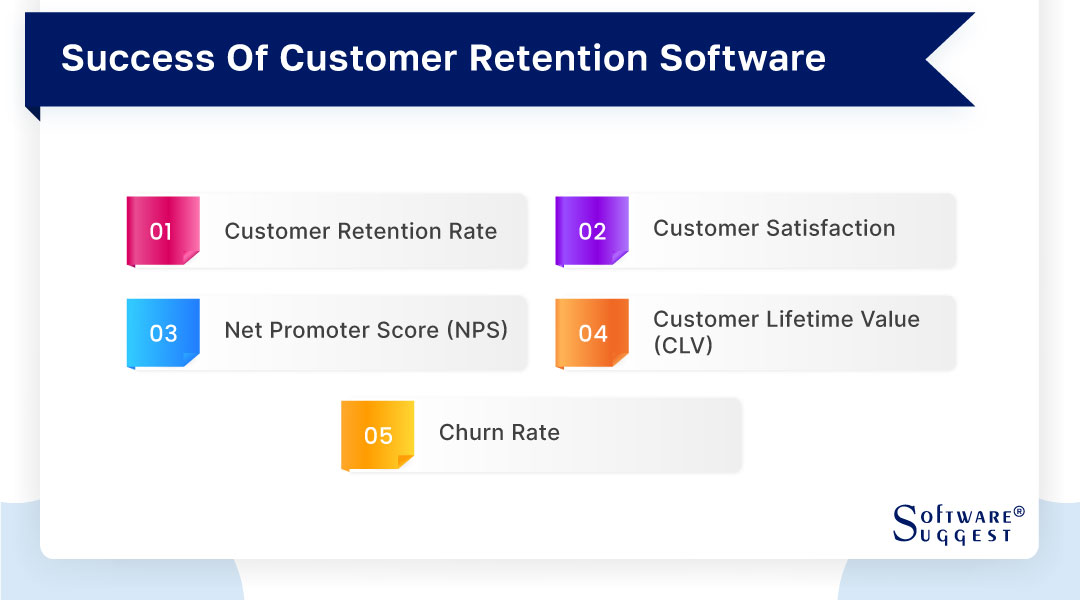
-
Customer retention rate
The percentage of customers that a company successfully retains over a given time period is measured by the customer retention rate, which serves as a fundamental metric.
This rate is calculated by multiplying the result of dividing the number of retained customers by the total number of customers at the beginning of the period by 100. A high customer retention rate demonstrates how well the software engages and satisfies users, promoting brand loyalty.
-
Customer satisfaction
Customer satisfaction assesses the level of contentment and fulfillment that customers feel during their overall interaction with a company. Businesses can assess customer satisfaction levels using feedback collection methods such as surveys, interviews, or online reviews.
Customer satisfaction is positively influenced by a successful customer retention management system that provides personalized experiences, resolves issues quickly, and consistently delivers value.
-
Net Promoter Score (NPS)
NPS is a popular metric that helps businesses determine customer advocacy and loyalty. It involves asking customers how likely they are, on a scale of 0 to 10, to recommend a friend or colleague to our business, product, or service. Customers are divided into three groups based on their responses: Promoters (score 9–10), Passives (score 7-8), and Detractors (score 0-6).
By deducting the percentage of Detractors from the percentage of Promoters, the NPS is calculated. A higher NPS reflects both customer satisfaction and their propensity to actively promote the brand. This acts as a reliable indicator of customer retention software success.
-
Customer Lifetime Value (CLV)
CLV is a metric that predicts the net profit generated by a customer over the course of their relationship with a company. It considers variables such as purchase frequency, average order value, and customer lifetime.
Businesses can gain insights into the long-term value provided by their customers and assess how effectively customer retention software maximizes that value by measuring CLV. A successful software solution should increase CLV by cultivating long-term customer relationships and encouraging upselling opportunities.
-
Churn rate
The churn rate represents the polar opposite of client retention. High customer churn rates suggest ineffective customer retention, which may be caused by insufficient customer retention software. Businesses can easily identify potential problems and enhance their retention strategies by keeping an eye on the churn rate.
By diligently monitoring and optimizing all these metrics, businesses can seamlessly gauge the effectiveness of their customer retention software. Through this, they can easily make data-driven decisions which further boosts revenue.
Current Trends in Customer Retention Software
Customer retention software integrates various technologies and strategies to enhance customer experience and maximize retention rates.
When it comes down to the current trends in customer retention software, the list can be a long one. Some of them are written below; let’s take a look at them!
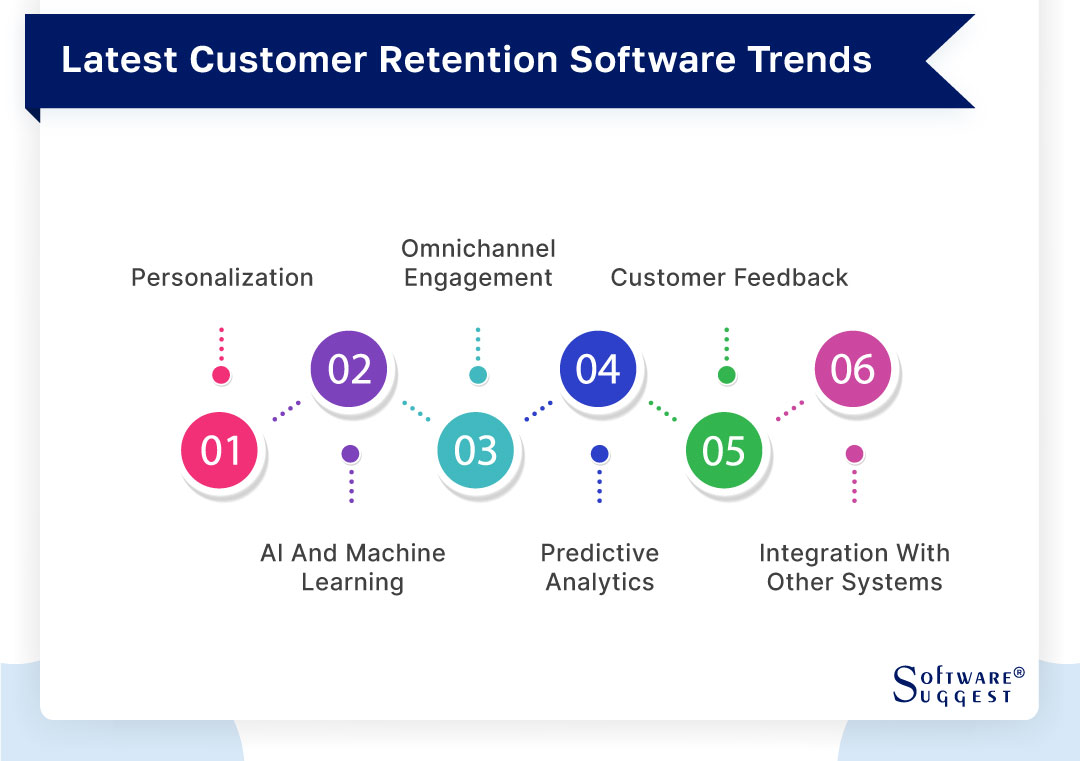
-
Personalization
The use of personalization in customer retention software has become a major trend. Customers now demand individualized services that address their specific preferences and needs. Companies are using data analytics and customer insights to deliver personalized interactions across various touchpoints.
Organizations can gather and analyze customer data, such as purchase history, browsing habits, and demographic data, with the help of customer retention software. With the help of this data, targeted marketing initiatives and personalized communications are then developed, leading to stronger customer relationships.
-
AI and machine learning
Customer retention strategies are being transformed by artificial intelligence (AI) and machine learning. AI-powered algorithms can analyze massive amounts of customer data, identify patterns, and accurately predict customer behavior.
These technologies enable organizations to identify at-risk customers proactively, provide timely interventions, and provide relevant offers, ultimately improving customer retention and lowering churn rates.
-
Omnichannel engagement
Customers interact with businesses through various channels, both online and offline. Because it enables businesses to deliver a seamless and consistent experience across all touchpoints, omnichannel engagement has emerged as a crucial trend in customer retention software.
Businesses can integrate a variety of communication channels, including websites, social media platforms, and chatbots, thanks to customer retention software. Customers can switch between channels without losing context thanks to this integration, which also ensures that they get consistent messaging and have a unified experience.
-
Predictive analytics
Customer retention methods are increasingly utilizing predictive analytics. Using past data and sophisticated statistical models, customer retention software can forecast future customer behavior and identify potential churn threats. Businesses can take proactive steps to retain customers thanks to these predictive analytics capabilities.
To reduce these risks and increase customer retention, businesses might, for instance, identify the churn-causing variables and adopt focused retention activities.
-
Customer feedback
Customer feedback is essential for gauging client satisfaction, finding areas for development, and bolstering retention efforts. Client retention software contains systems for gathering and analyzing client feedback.
These feedback techniques provide useful information regarding client preferences, pain points, and general levels of satisfaction. Businesses can boost customer retention by using feedback from customers to make data-driven decisions and continuously optimize their products and services.
-
Integration with other systems
Effective client retention tactics must be in sync with the organization's systems and platforms. Customer retention software combines with customer relationship management (CRM) systems, marketing automation platforms, and other business tools to streamline data flow and enhance the entire customer experience.
The efficiency of retention programs is increased thanks to integration with marketing automation solutions, which enables targeted and automated retention campaigns across numerous channels.
Adopting these cutting-edge trends enables businesses to go beyond traditional customer retention strategies and seize unprecedented opportunities. Businesses that follow these trends can create unbreakable bonds with their customers, resulting in enhanced customer relationships built on trust and loyalty.
Conclusion
Businesses can proactively identify at-risk customers and deliver targeted interventions thanks to AI and machine learning capabilities. Engagement in omnichannel strategies ensures a seamless customer experience at all points of contact.
Effective retention strategies can be developed with the help of predictive analytics. Businesses can continuously improve their offerings by gathering and analyzing customer feedback.
Data flow is streamlined through integration with other systems, which also improves customer satisfaction. The best customer retention platform equips companies to forge closer bonds, raise customer satisfaction, and promote long-term expansion. Connect with our expert teams to learn more about customer retention software and how you can adopt one.
FAQs
Customer retention software is created specifically to help businesses stop losing clients. Customer retention software can identify potential churn risks by using advanced analytics and predictive modeling, allowing businesses to take proactive steps to keep customers.
To spot indications of disengagement or dissatisfaction, it analyzes various customer data points, including purchase history, engagement patterns, and customer feedback.
Businesses can significantly lower customer churn and promote long-term customer loyalty by utilizing the insights and capabilities offered by customer retention software.
Businesses can use this interface to centralize customer data and improve procedures, resulting in more efficient customer retention initiatives.
Businesses have access to detailed customer profiles, track customer interactions, and adapt retention strategies based on individual customer histories by combining customer retention software with CRM systems.
This connection provides organizations with a comprehensive perspective of their clients, enabling them to conduct personalized and targeted retention activities.
By Industries























